Selcouth Chronicles Week 12
Hello family and friends! Welcome to week 12 of the Selcouth Chronicles.
Week 12: March 24 - March 30
March 27 🛫 Laos -> 🛬 Chiang Mai (Thailand)
March 28 (Sean) 🛫 Bangalore -> 🛬 Chiang Mai (Thailand)
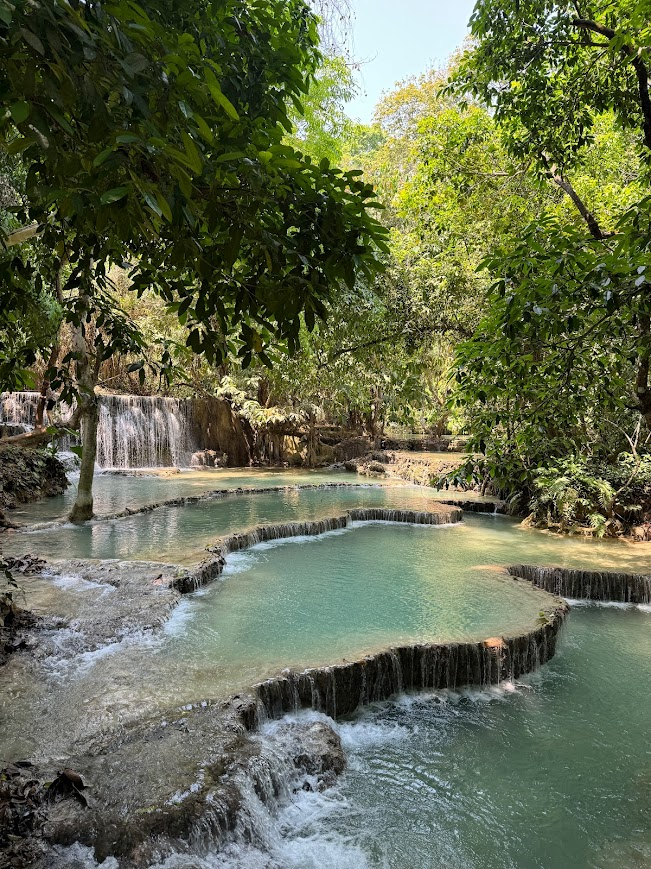
LAOS & THAILAND
Highlights: A zillion wats in Luang Prabang, Kuang Si Falls, Lao weaving class, Gavarek folktale show, Chiang Mai museums, Elephant Highlands experience, Wat Phra Singh, lots of sticky rice with mango
Caitlin:
This week we started off in Laos, which has the distinction of being the first country that the kids have been to that Sean has not. It’s a small country, but even so we didn’t have time to see all of it. Aviva, Chris and I had decided a few weeks ago that Luang Prabang would be the best spot to stay, as it was the former capital of the Kingdom of Laos and is steeped in history. We spent our first afternoon visiting a sampling of temples: Wat Xienthong, Wat Sensoukharam, Wat Syrimoungkhoun Xaiyaram, and Wat Souvannakhiri. The entire town is a UNESCO World Heritage Site, and some people say it’s the religious heart of the country. It felt like we could hardly turn a corner without finding another well-preserved wat!
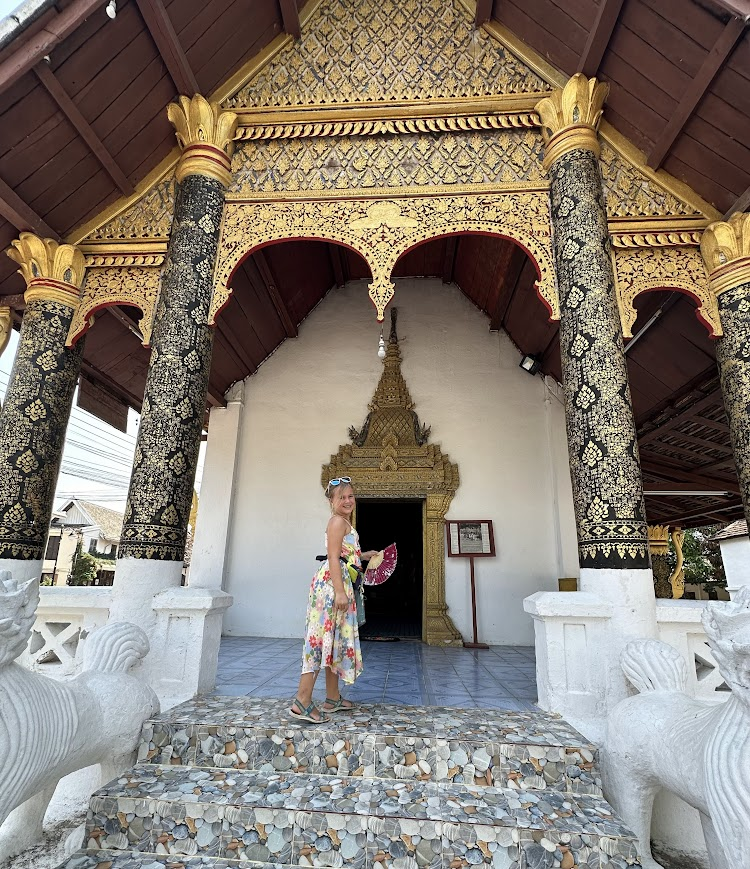
On Monday we ventured out of the city to see Kuang Si Falls. The ride out was quite an adventure; I think it’s safe to say that of all the places my family has been so far Laos takes the prize for roughest roads. In town there is a lot of road work going on and it’s clear that they’re trying to upgrade their infrastructure in that regard, but outside of town was riddled with giant potholes. Our driver adeptly swerved around the largest ones but for the most part we went right over them and getting shaken like maracas was just part of the experience.
The falls are a major tourist attraction in the area, and the walk up includes a stroll through the Tat Kuang Si Bear Rescue Centre, which delighted the kids with some resident bears lounging on hammocks in the manner of a lazy human on a hot day. Then we continued our walk uphill to reach the swimming areas of the falls. The water of Kuang Si Falls is colored by dissolving limestone and changes throughout the year. When we visited it was a beautiful bluish teal, but in the wet season it changes to a deep green. The teal color looked very inviting and warm, but the water was colder than I expected! I stuck to wading, but the kids were undeterred by the temperature and had a wonderful time splashing and playing in the various pools and waterfalls. No matter how deep (or not) we ventured in, the cool water was a welcome respite from the heat!
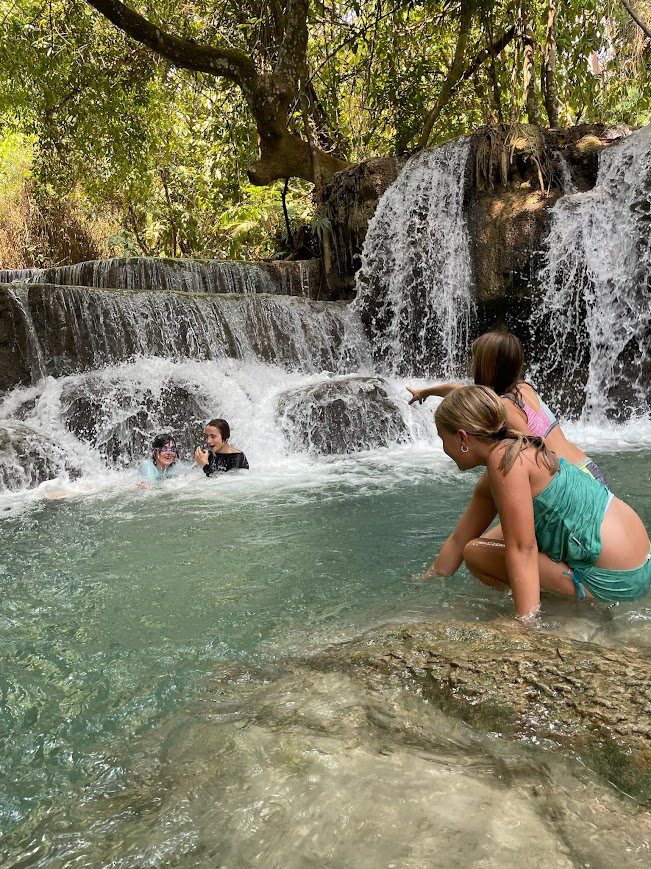
Textiles are an important part of the cultural heritage of Laos, and I really looked forward to our activities on Tuesday: a traditional Lao weaving class! Abby, Aurelia, Aviva and I all got to try this. I had no prior weaving experience and didn’t have expectations of being very adept at the loom. Even so, I was surprised at how difficult weaving turned out to be! Each person had a master weaver helping us who was in charge of adjusting the looms so that the pattern came out correctly, and thank goodness for that because I never would have managed. At one point, I felt like I was finally getting the hang of things and finding a good rhythm… then my helper took over for a minute to demonstrate something, and her speed and skill were stunning. I still can’t quite understand how she was able to work so quickly. It was definitely a humbling experience, but the accomplishment of making even a small piece was so gratifying!
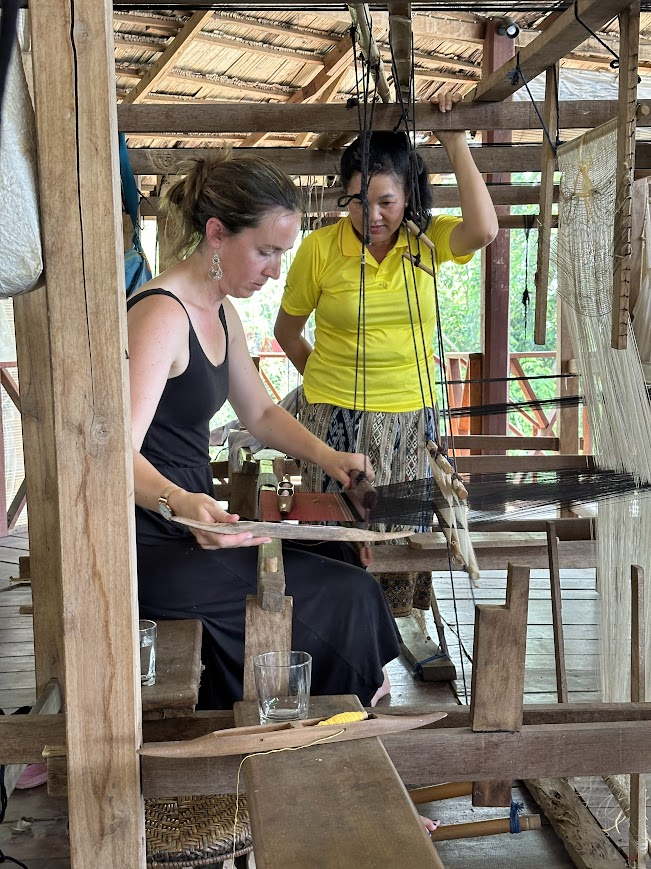
On the way to dinner that night, we stumbled across a sign for a local storytelling project. We went straight back after eating and spent a fun hour listening to traditional folktales about Laos and Luang Prabang.
Wednesday was our last full day as a travel pod with the Pauls, and we left Laos together to move along to Chiang Mai, Thailand. We were all pretty tired from the trip and wanted to enjoy our last day together, so we kept things low key. We settled in at our Airbnb and enjoyed a tasty Thai dinner nearby.
Thursday was exciting because Sean was reunited with us! Unfortunately, his journey entailed a full day at work in Bangalore, followed by a flight to Singapore, followed by a flight to Chiang Mai. It was a very tiring trip for him, but he attempted to rally and come out with the rest of us after he landed in the morning. It was a valiant effort, but when he found an area with a short film while exploring the Chiang Mai City Arts & Cultural Museum he let himself doze off while the rest of us watched the film… and then we watched it again, just to give him a little more time to nap. ;) After that he and Abby headed back to the Airbnb for a real rest, while everyone else made a quick stop at the Chiang Mai House of Photography. It’s a small but sweet space with light blue walls and ceilings, and the current exhibit is a charming collection of photos featuring flowers of the region. It was lovely! After that we said goodbye to the Pauls, as they were meeting up with other friends for the next leg of their trip. However, our paths will be overlapping for the near future, so it was more of a “see you later” than a real goodbye.
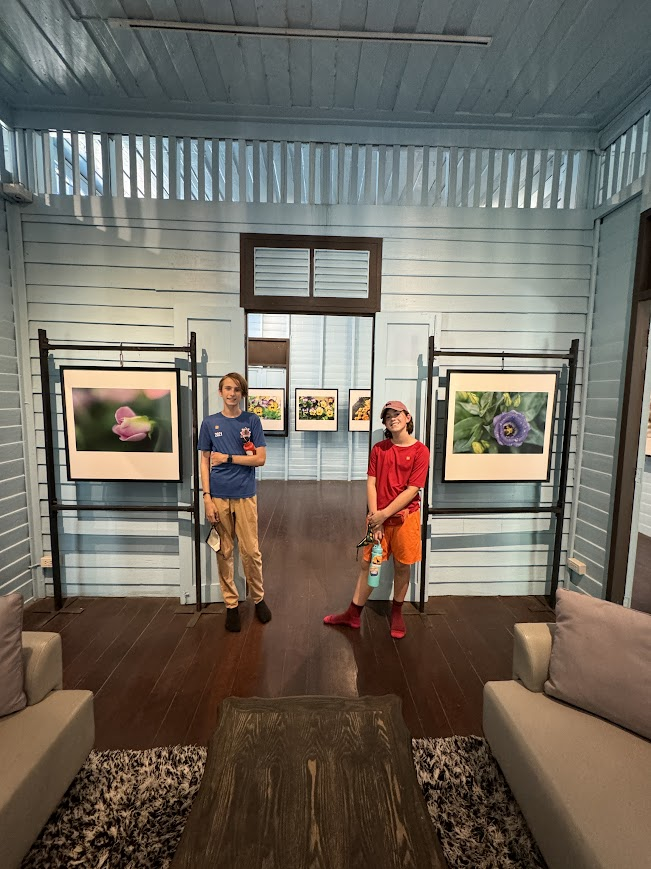
Friday was a day I’ve been looking forward to since before we even left home; it was our day at an elephant sanctuary! There are many elephant parks in this region and some are of dubious quality, but I managed to find one that is known for their compassionate handling of animal welfare. All of their elephants are rescued, and most live at the Elephant Nature Park, but a big part of the reason that I chose ENP was that they also offer an Elephant Highlands experience, which allows you to interact closely with these amazing animals in a very personal way. Sean will be writing about the day in more detail, but I’ll share that it was one of the highlights of the trip for me. We had an amazing day!
Saturday was our last full day in Chiang Mai, and we still had a number of spots we wanted to visit. We started off with Wat Phra Singh, the largest wat in the city. It was conveniently located right around the corner from where we were staying, and it was an impressive space. It’s easy to see why this wat has such importance to Chiang Mai, and we were very impressed by the elaborate buildings and grounds. However, the temperature quickly topped 90 degrees, so for our next stop we enjoyed the interesting and informative (and air conditioned!) exhibits of the Lanna Folk Museum. The Lanna Kingdom ruled northern Thailand before being absorbed by Siam, and we enjoyed learning more about the history of the region. After lunch we visited the Treasury Museum. This museum stop was a special request from James, who was very excited to learn more about the currency of Thailand. I hadn’t realized that this was an area of interest for him, but he had been looking forward to the visit for days. The museum was small but a surprisingly good source of historical information about the ancient cultures of Thailand and the surrounding regions that were connected by trade routes.
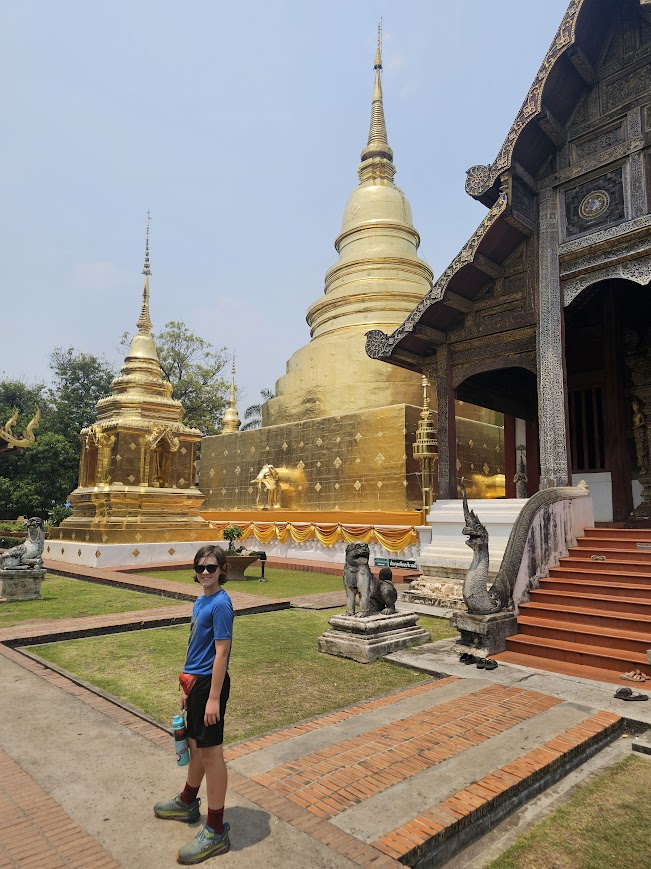
We finished our last day with visits to two more wats (Wat Chedi Luang and Wat Phan Tao) before packing up for our trip to Bangkok the next morning. I must admit that the only real reason I added Chiang Mai to our itinerary was for the elephant sanctuary, but I found that the city was full of enjoyable activities. It was a fun week in two cities with interesting and important histories.
Abby:
Traveling the world is an adventure. It’s an experience like no other. We try new things every day and it’s mostly awesome, but that can also get very, very tiring. Here’s a list of some things that we’ve had to adjust to – see if you can guess which ones I’ve liked and which ones I haven’t:
· Not flushing toilet paper. In Southeast Asia, many of the cities and towns have old pipes that can’t break down toilet paper properly. We have to throw it in the trash instead!
· Taking new forms of transportation. At home we are used to using our own cars or walking. On the trip we’ve been walking way more than usual, plus using airplanes, Grabs/Ubers, minibuses, subways, bullet trains, overnight trains, rental cars, ferries, “junk” boats, cruise boats, tuk tuks, golf carts/buggies, etc.
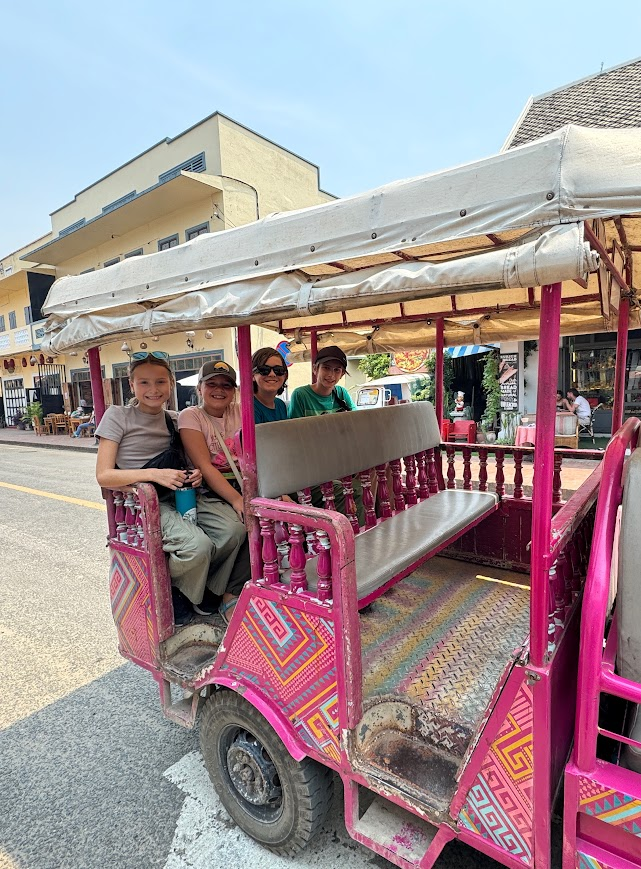
· Learning new ways to communicate. Most of the places we’ve been speak different languages from us. We use hand gestures a lot, and we always at least learn the words for “hello” and “thank you” (and sometimes “excuse me”) in different countries. Instead of waving or shaking hands, some cultures bow to greet people or to be polite.
· Living out of a suitcase. It is good not having too much stuff, but sometimes we don’t have things we want with us. I’m also tired of wearing the same clothes all the time. On the other hand, we are learning that you don’t really need most of the stuff we normally live with. I usually get souvenirs like keychains because they can be attached to our bags. We have to be careful because anything we buy we have to carry around with us for months.
· Almost always eating out, no Mom food every day. We don’t always stay in places with kitchens, and even when we do have a kitchen we don’t usually have all of the ingredients and tools to make our favorite meals from home. We love trying all the new foods where we are visiting and it’s fun to try new things to eat, but we miss Mom’s cooking. 😔
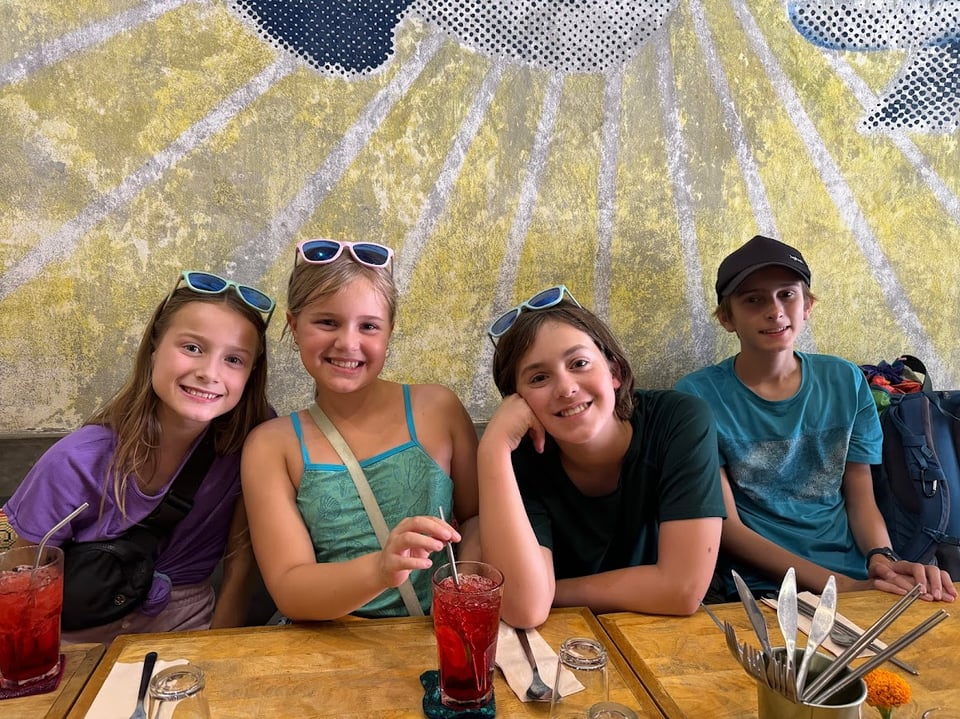
· Getting my picture taken by strangers. Since we’ve arrived in Southeast Asia, we’ve noticed that a lot of people we don’t know have been taking my picture. It can be very uncomfortable and most of the time it’s not fun to feel like I stick out. Now I have an idea of what it might be like for people in the US who feel different too.
· Trying things I’ve never done before. This week Mom, Aviva, Aurelia and I took a weaving class in Luang Prabang. Doing the weaving was tons of fun, yet very hard and tiring. After she finished, Mom said that she had a “new respect for weavers.” You need an incredible sense of memory to remember how to do all those patterns. There were two patterns that we could learn to weave for our lesson. First was the Naga, the giant, magical holy snake, which Mom chose. Second was the Magic Key. I did the Key pattern, because it was much simpler than the Naga pattern. Even though it was very difficult, I’m glad that I went to the class and I’m proud of the piece that I wove!
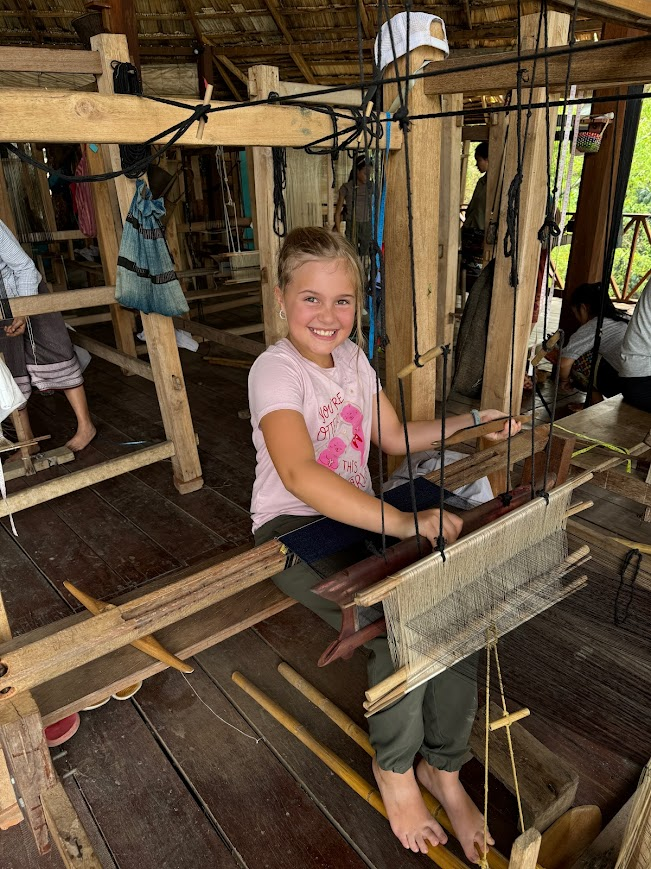
James: 💵💵💵💵💵
Before any sort of money or currency was in Thailand, they used the barter system. The barter system is where one person has a specific type of object or good and whenever someone wants some of it, they either straight-up trade or they try to wrangle a better deal out of the other. It marked the beginning of Thailand’s monetary system.
Unfortunately, bartering didn’t work out due to very, very pushy merchants. In fact, some of them were so pushy that their customers would actually come to blows in the middle of the street just for a fair deal. The government responded with the supposed-to-be-temporary cowry shell system. The shells worked like coins, so there were no more random price hikes. As a result, merchants got more customers and customers could buy the things they wanted at lower costs. Thus, money was introduced to Thailand.
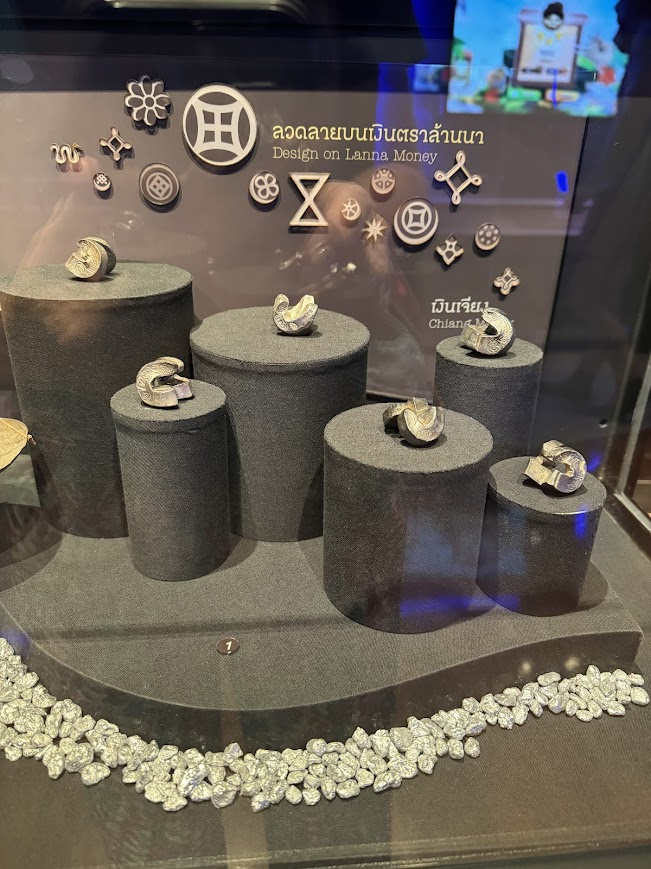
Innovations quickly followed and over the next couple hundred years, other types of coins were added to the mix, including the first metal coins. They were called Siriwatsa coins and were made of metal with carvings of a cowrie shell on the front. The back had more variety with either the Siriwatsa (a symbol of abundance, consisting of two triangles facing point-down on the top and bottom with two things that look like wisps of smoke curling out of the spot where they meet), or the Sun. They were the most common coin for a while until the kingdom of Lanna decided that they wanted to make their own type of coin, dubbed “Thok” money. It was the first silver coin ever to be put in circulation in Thailand, but there was one problem with them: they were massive! The coins measured around 3 inches in length and width, making them an absolute pain to carry around. Despite the burden of coins’ weight, the invention of Thok money was a major step towards the looks and design of modern money. Since it was such a huge and life-changing innovation, naturally people quickly stopped caring about it and the coin’s popularity died out in 1800 BE.
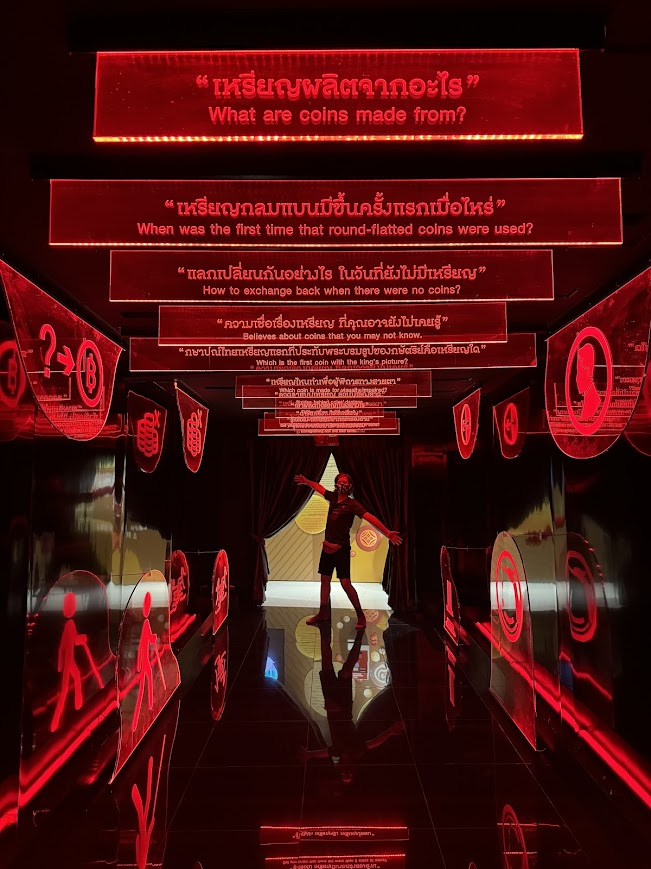
Around that time, other cities also began to invent new coins. Those included Chiang money (1200-1600 BE) and Dok Mai money (1800-1850 BE). They, like the Thok, were huge at first but began to lose popularity over time. The final blow to their popularity came when Thailand really opened up their borders to international trade and new ideas poured in. Lanna added the Pod Duang, a coin that was made to look like silver maggots. It was brought in by a nation called Sukhothai. They were an instant success at first but were not very practical. (I like to think that some higher-up at the time just wanted to make maggot coins and got away with it.) There’s another version of it called the Atuya Pod Duang, which is the same thing as the first except more valuable because of the gold inlaid inside. The rupee (Indian currency) was also brought in, but it was only in use for a short time before it disappeared from Thailand.
Everything else from that point on was just spin-offs of the originals. Finally something new came along in 1900 BE, when paper money became reality. To keep track of all the currency in their land at the time, the king and his advisors decided to rename all currency in Thailand to Baht.
Just like that, modern currency came to be in Thailand.
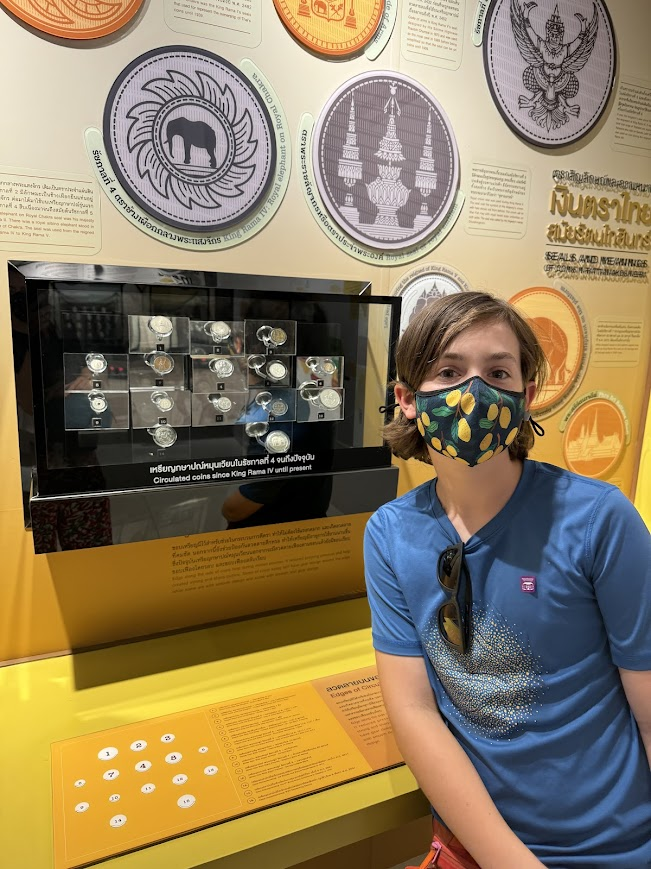
Sean:
There have been a handful of moments that we have penciled in during the trip as must-do, look-forward-to moments. This week was one of those with our trip to the Elephant Nature Park (ENP) in Chiang Mai. According to their website, the ENP is “an elephant rescue and rehabilitation centre in Northern Thailand... It is the first ethical elephant sanctuary of its kind established in Asia and currently provides a caring home to over 100 elephants.”
We chose to do their Elephant Highlands day, which does not include a visit to the main park, but allows you to walk with and feed the elephants versus just seeing them. The day started with a drive from their office in Chiang Mai up into the highlands, just over an hour and a half drive up some winding roads. Once there, we were immediately put to work cutting up watermelons with machetes to feed the elephants. This was an interesting experience, and luckily all of our fingers are still attached.
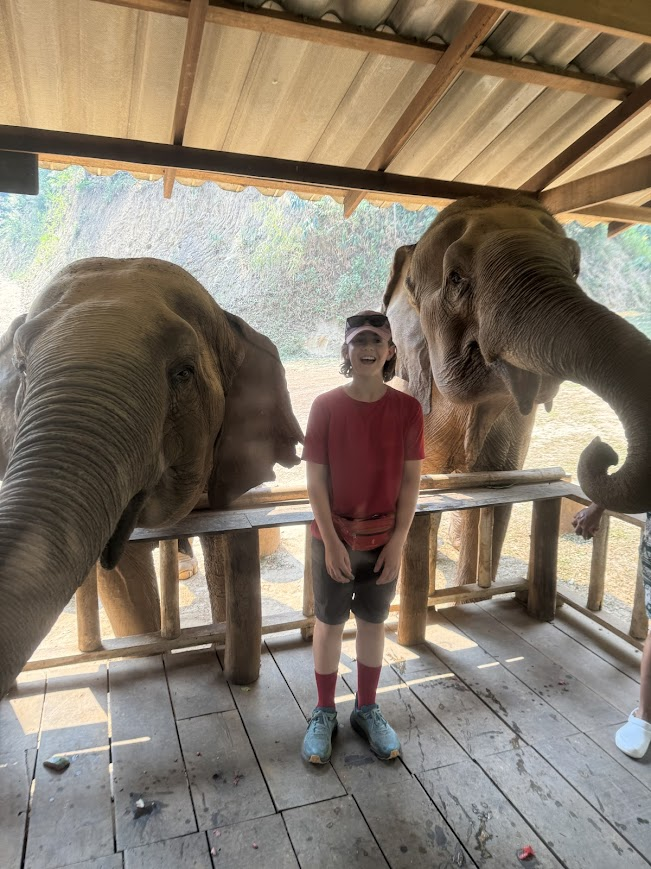
Once the watermelons were cut, the elephants came down the path to the hut we were in. There were four total, three females and one 6 year old male that had been adopted by one of the females. All four came up to the hut and immediately began taking pieces of watermelon from us. Their appetites were insatiable and it was hard to keep up! Everyone got a kick out of it and very quickly the watermelon was gone. Since the baby is a bit playful and humans can’t really play with elephants, they escorted the baby and it’s adopted mom away and we began walking with the remaining two (KhamPaeng and NongPop). Since these elephants are primarily motivated by food, we fed them bananas as we walked to keep them going.
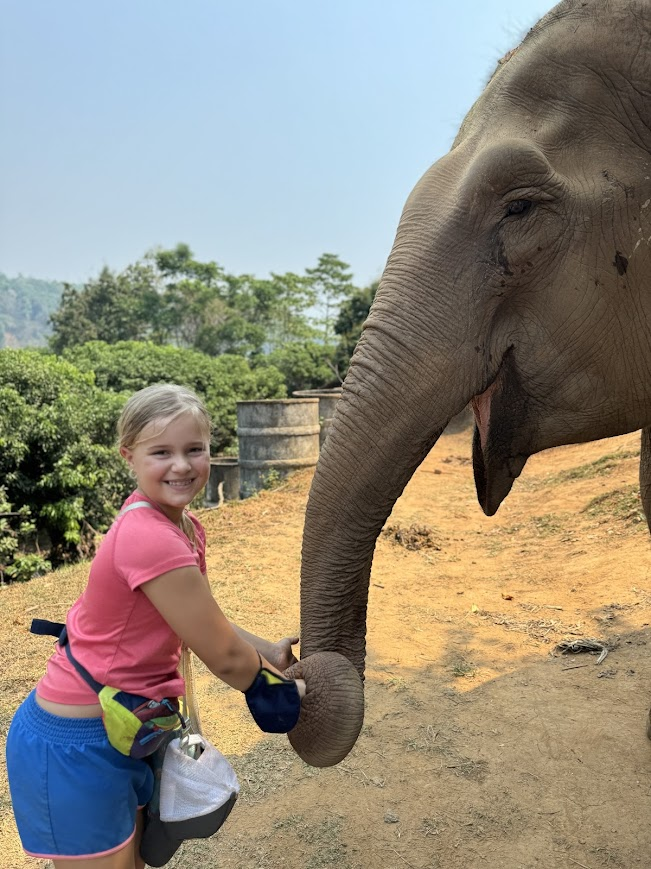
At the end of the walk the elephants were put into their pen and we had lunch. This was a fantastic spread of authentic Thai dishes and we ate our fill. After lunch we walked to a field where the elephants were fed banana tree leaves. Some cows also came by in hopes of stealing some of the leaves, but Pop ran at them and the cows quickly changed their minds about stealing food. Here we also learned how to properly pet an elephant (flat palm, not scratching) and how to tell when they’re happy (flapping ears and crossed legs).
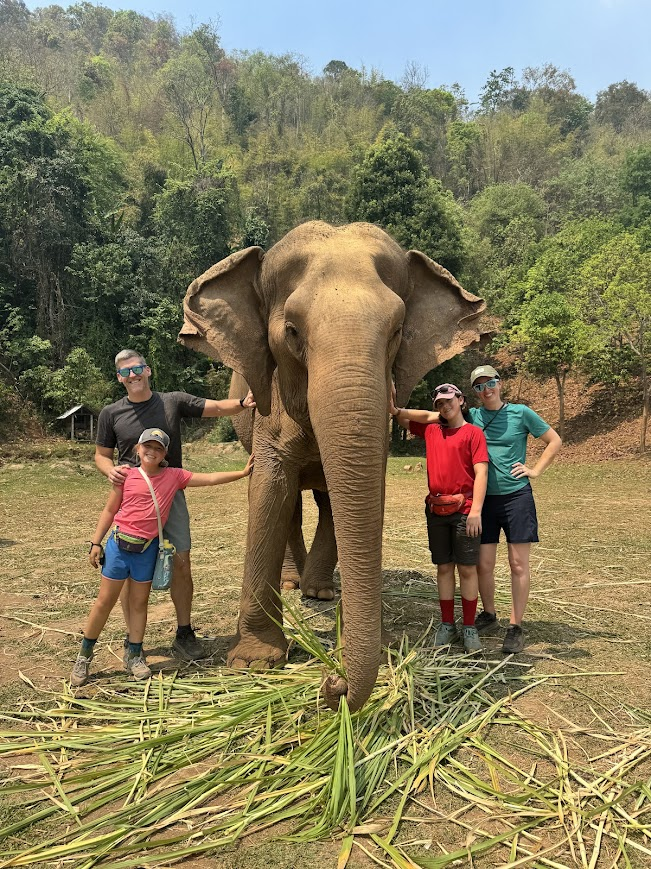
After a hard day of eating, we all needed to cool off, so we all went into the elephant pool together. We were given buckets with which to throw water on the elephants, and they threw corn and bananas in the pool for the elephants to eat. Many people slipped into the water, the worst of it being James who went all the way up to his neck. After that, he gave up and just waded around the pool collecting food. Pop took notice and started following James in the pool, which was cute and quite funny.
The finale of our day with the elephants was creating a rice ball treat for them. This included rice, corn, bananas, tamarind, salt, and elephant feed. We mashed this all together with our hands, then formed it into a ball and fed it to the elephants. The instructions were to hold up the ball over your head to make sure the elephant saw it, then when they opened their mouths, plop it in there! Sounds easy, but it’s a bit nerve wracking putting your hands in an elephant's mouth, and Abby dropped a few in her attempts. In the end, we were able to feed all four elephants their final treat, say our goodbyes, and head back into town. It was a truly memorable day and an experience I know I will cherish for the rest of my life.
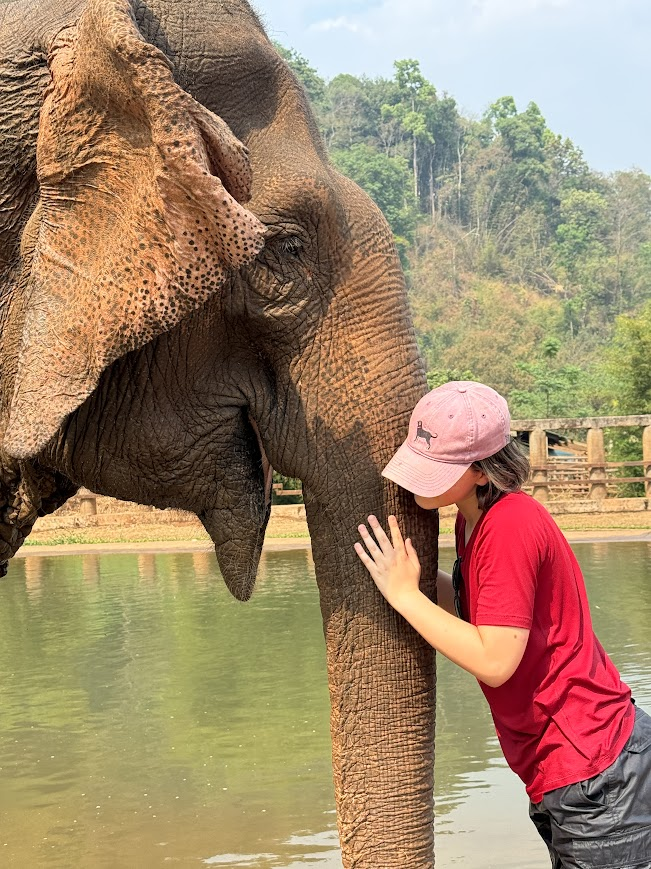
See you next week!
Sean, Caitlin, James, and Abby
Catching up? Read week 1, 2, 3, 4, 5, 6, 7, 8, 9, 10, or 11.
Want to hear what Aviva, Chris, Sabian, and Aurelia had to say about this week? You can read their newsletter here.